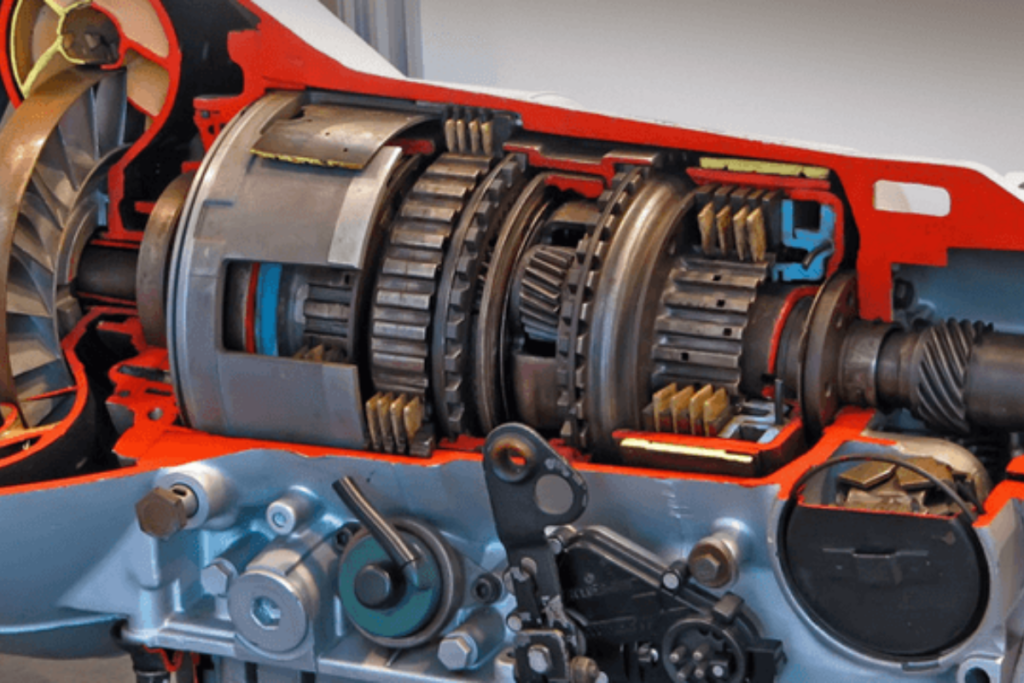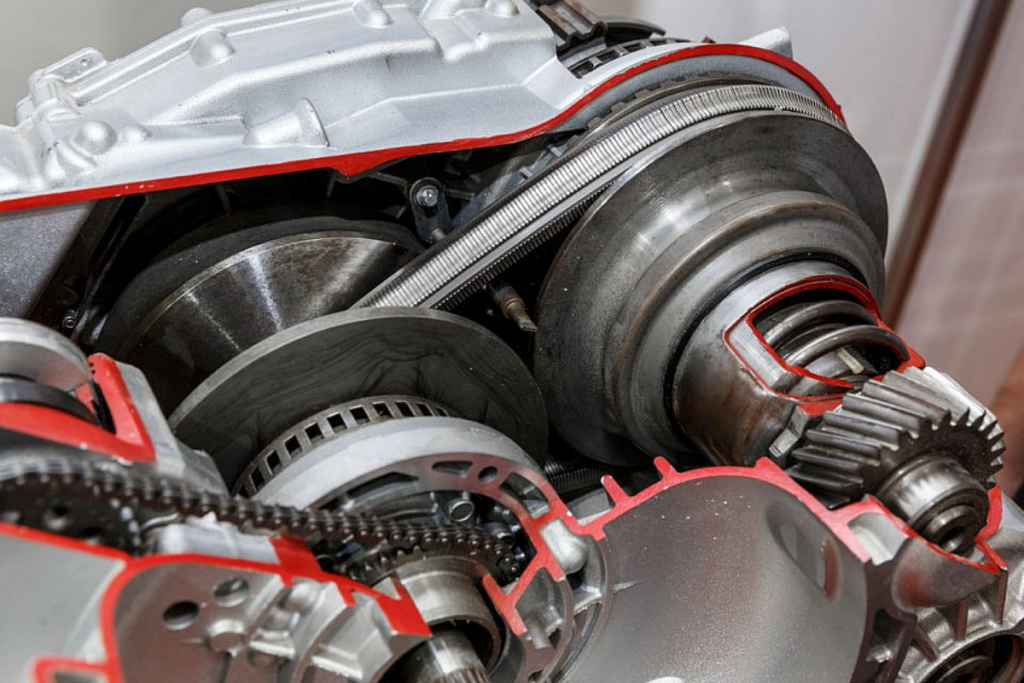📖 Table of Content:
Variable transmissions, especially continuously variable transmissions (CVTs), have become increasingly popular in modern vehicles due to their ability to provide smooth and efficient power delivery. Unlike traditional automatic transmissions, CVTs use a system of belts and pulleys to offer an infinite number of gear ratios. This design leads to improved fuel efficiency and a smoother driving experience. However, like any technology, CVTs come with their own set of challenges and potential issues. Understanding these variable transmission problems can help car owners better maintain their vehicles and avoid costly repairs.
What is a Variable Transmission?
A variable transmission, particularly the Continuously Variable Transmission (CVT), is a type of automatic transmission that provides a seamless range of gear ratios, unlike traditional automatic transmissions that have a fixed number of gears.
Explanation of CVT and its Working Mechanism
A CVT operates using a pair of variable-diameter pulleys connected by a belt. One pulley is connected to the engine (input pulley), and the other is connected to the drive wheels (output pulley). The pulleys can change their diameters by moving closer together or farther apart, which adjusts the belt’s position and effectively changes the gear ratio. This allows the CVT to provide an infinite number of gear ratios between its lowest and highest settings, ensuring that the engine operates at the most efficient RPM for any given speed.
Comparison with Traditional Automatic Transmissions
Traditional automatic transmissions have a set number of gears (e.g., 6-speed, 8-speed). Each gear provides a specific ratio of engine speed to wheel speed. Shifting between these gears can result in noticeable changes in power delivery and, sometimes, a slight delay.
In contrast, CVTs eliminate the need for shifting gears entirely. This results in a smoother driving experience with no interruption in power delivery. However, some drivers may find the lack of shifting less engaging and less familiar compared to traditional automatics. Additionally, CVTs can be more prone to certain types of wear and tear due to the continuous adjustment of the pulleys and belt.
Common Problems with Variable Transmissions
Overheating
Causes and Symptoms: Overheating is a common issue with CVTs, often caused by prolonged driving under heavy loads or in hot climates. Symptoms include a burning smell, warning lights, and decreased performance.
Preventive Measures: To prevent overheating, ensure regular maintenance, use the recommended transmission fluid, and avoid driving under extreme conditions for extended periods.
Slipping
Identifying Transmission Slips: Transmission slipping occurs when the CVT fails to maintain a steady gear ratio, leading to inconsistent acceleration and a lack of power.
Impact on Vehicle Performance: Slipping can significantly reduce the vehicle’s performance, causing erratic acceleration and potentially leading to more severe transmission damage if not addressed promptly.
Shuddering and Jerking
Common Reasons for Shuddering: Shuddering or jerking during acceleration can result from worn belts, low transmission fluid levels, or software issues within the CVT system.
How to Address These Issues: Regularly check and maintain fluid levels, ensure timely software updates, and seek professional inspection if shuddering persists.
Delayed Engagement
Symptoms and Potential Causes: Delayed engagement, where the transmission takes longer to shift from park to drive or reverse, can be caused by low fluid levels, worn components, or electronic control issues.
Solutions for Delayed Gear Engagement: Check and refill transmission fluid as needed, replace worn parts, and ensure the transmission control module is functioning correctly.
Noise Issues
Types of Noises: Common noises associated with CVT problems include whining, humming, or clunking sounds, which may indicate issues with the pulleys, belts, or fluid levels.
Diagnosing and Fixing Noise Problems: Diagnose noise issues by checking fluid levels, inspecting the transmission for wear and tear, and seeking professional assistance for comprehensive diagnostics and repairs.
Maintenance Tips for Variable Transmissions
Regular Check-Ups and Fluid Changes
Regular maintenance is crucial for the longevity of a CVT. Frequent check-ups help detect potential issues early, preventing major problems down the line. Routine fluid changes are essential as the transmission fluid in a CVT plays a vital role in its operation and cooling. Replacing the fluid at recommended intervals ensures optimal performance and prevents overheating and slipping.
Importance of Using the Right Transmission Fluid
Using the correct transmission fluid is paramount for CVTs. Each manufacturer specifies a particular type of fluid that matches the needs of the transmission. Using the wrong fluid can lead to reduced performance, increased wear, and potential damage. Always refer to your vehicle’s manual or consult a professional to ensure the right fluid is used.
Software Updates and Recalibrations
Modern CVTs rely heavily on software to manage their operations. Regular software updates can improve performance, fix bugs, and enhance reliability. Additionally, recalibrations may be necessary after certain repairs or component replacements to ensure the transmission functions correctly. Keeping the transmission software up to date is a simple yet effective way to maintain its health and efficiency.
When to See a Professional
Signs that Require Immediate Professional Attention
- Persistent Slipping: If you notice your transmission consistently slipping out of gear, it’s crucial to have it checked immediately. Slipping can lead to a lack of acceleration and overall poor performance.
- Unusual Noises: Any persistent whining, humming, or clunking noises from the transmission area should be inspected by a professional. These noises often indicate mechanical issues that can worsen over time.
- Fluid Leaks: Transmission fluid leaks are a clear sign that something is wrong. Check for red or brown fluid spots under your car. Low transmission fluid can cause overheating and damage the transmission.
- Burning Smell: A burning smell, often accompanied by overheating, indicates that the transmission fluid is degrading or that the transmission is overheating. Both scenarios require immediate attention to prevent severe damage.
- Delayed Engagement: If there is a significant delay when shifting from park to drive or reverse, it may signal an internal problem with the transmission.
- Dashboard Warning Lights: Transmission warning lights on your dashboard should never be ignored. These lights indicate that the car’s computer has detected a problem with the transmission system.
Finding a Reliable Mechanic or Service Center
Warranty and Guarantees: A reputable mechanic or service center should offer warranties or guarantees on their work. This ensures that if the problem persists or reoccurs, you can have it addressed without additional costs.
Check Reviews and Ratings: Look for mechanics or service centers with positive reviews and high ratings online. Websites like Yelp, Google Reviews, and the Better Business Bureau can provide insights into the reputation of a service provider.
Certifications and Experience: Ensure the mechanic or service center has the necessary certifications (like ASE certification) and experience with CVT and variable transmissions. Specialized knowledge is crucial for accurately diagnosing and repairing transmission issues.
Ask for Recommendations: Personal recommendations from friends, family, or colleagues can lead you to trustworthy mechanics. Word-of-mouth referrals often highlight reliable and honest service providers.
Get Multiple Quotes: Before committing to a repair, obtain quotes from multiple mechanics. This will help you understand the typical cost for your needed services and avoid overpaying.
Case Studies and Real-life Experiences
Common Issues Reported by Vehicle Owners
Overheating: Many drivers have reported their CVTs overheating, especially during long drives or in hot climates. This can lead to the transmission going into a fail-safe mode, reducing performance to prevent damage.
Slipping: Some vehicle owners experience the transmission slipping, particularly during acceleration. This issue can cause a sudden loss of power and erratic performance.
Shuddering: Shuddering or jerking during acceleration is another common complaint. This can be particularly noticeable when starting from a stop or during low-speed driving.
Delayed Engagement: Delays in shifting from park to drive or reverse are frequently reported. This can be frustrating and potentially dangerous if immediate response is needed.
Noise: Unusual noises such as whining, humming, or rattling can indicate problems within the CVT. These noises often become more pronounced with increased speed or load.
Solutions and Preventive Measures from Experts
Professional Inspection: Regular inspections by a certified mechanic can catch potential problems early. If any unusual symptoms are noticed, seeking professional advice immediately can prevent more severe damage.
Regular Maintenance: Routine maintenance, including regular fluid changes with the correct type of transmission fluid, is crucial. Following the manufacturer’s maintenance schedule can prevent many common issues.
Cooling Solutions: Installing an auxiliary transmission cooler can help prevent overheating. Ensuring that the transmission fluid is always at the correct level can also mitigate overheating risks.
Software Updates: Keeping the vehicle’s software up-to-date can resolve many CVT issues, as manufacturers often release updates to improve performance and fix bugs.
Driving Habits: Avoiding aggressive driving and allowing the vehicle to warm up before driving can reduce strain on the CVT. Smooth acceleration and deceleration can also extend the transmission’s lifespan.
Future of Variable Transmissions
Advances in Technology
The technology behind variable transmissions, particularly Continuously Variable Transmissions (CVTs), has seen significant advancements in recent years. Modern CVTs are incorporating improved materials and innovative designs that enhance their durability and efficiency. Manufacturers are focusing on advancements such as:
- Enhanced Belt and Pulley Systems: New materials and designs are being developed to increase the strength and longevity of the belts and pulleys used in CVTs.
- Advanced Software Control: Modern CVTs now feature sophisticated electronic controls that optimize performance and efficiency, leading to smoother and more responsive driving experiences.
- Hybrid and Electric Vehicle Integration: CVTs are increasingly being adapted for use in hybrid and electric vehicles, which often require different performance characteristics compared to traditional internal combustion engines.
Predictions for CVT Reliability and Performance
Looking ahead, the reliability and performance of CVTs are expected to continue improving as technology evolves. Key predictions include:
Enhanced User Experience: With improvements in software and control systems, future CVTs are anticipated to offer even smoother and more intuitive driving experiences.
Increased Durability: Ongoing research and development are likely to lead to more robust CVT designs that can better withstand stress and wear, reducing the frequency of repairs and replacements.
Greater Efficiency: As technology advances, CVTs are expected to become even more efficient, contributing to better fuel economy and reduced emissions.
FAQs about Variable Transmission Problems
1. Does CVT have problems?
Yes, CVTs can encounter several issues, including overheating, slipping, shuddering, and noise. These problems can affect the performance and reliability of the vehicle. Regular maintenance and prompt repairs can help mitigate these issues.
2. Is CVT better than automatic?
CVTs offer smoother acceleration and better fuel efficiency compared to traditional automatic transmissions. However, some drivers prefer automatic transmissions for their familiar feel and greater reliability in high-torque situations. The choice depends on individual preferences and driving needs.
3. What are the weaknesses of CVT?
CVTs may have weaknesses such as potential overheating, slipping, and higher repair costs compared to traditional automatics. They can also exhibit a lack of responsiveness and a “rubber band” feel during acceleration.
4. क्या सीवीटी में समस्या है?
हां, CVT में विभिन्न समस्याएँ हो सकती हैं, जैसे कि ओवरहीटिंग, स्लिपिंग, झटके और शोर। इन समस्याओं से निपटने के लिए नियमित देखभाल और त्वरित मरम्मत आवश्यक हैं।
5. What are the symptoms of variable transmission problems?
Common symptoms include unusual noises, slipping during acceleration, shuddering or jerking, delayed gear engagement, and overheating. These signs indicate that the transmission may need attention or repair.
6. Variable transmission problems in Toyota?
Toyota CVTs may experience issues like slipping, shuddering, and overheating. Toyota vehicles are generally reliable, but it’s essential to monitor and address any symptoms of transmission problems promptly.
7. What are the problems with automatic variable transmissions?
Automatic variable transmissions, including CVTs, may face issues such as slipping, overheating, and delayed engagement. Regular maintenance can help prevent these problems.
8. Toyota CVT transmission problems?
Toyota CVTs have been reported to experience issues such as overheating, noise, and slipping. Ensuring regular maintenance and addressing any warning signs can help manage these problems effectively.
9. CVT transmission vs automatic?
CVT transmissions provide a smoother and more fuel-efficient drive compared to traditional automatic transmissions. However, automatic transmissions may offer better performance in high-torque situations and are often preferred for their durability.
10. Honda variable transmission problems?
Honda CVTs may encounter issues such as slipping, overheating, and abnormal noises. Regular service and timely repairs are crucial to maintaining the performance of Honda’s variable transmissions.
11. CVT transmission problems symptoms?
Symptoms of CVT transmission problems include slipping during acceleration, shuddering, overheating, unusual noises, and delayed gear changes. Addressing these issues early can prevent further damage.
12. How to fix CVT transmission problems?
To fix CVT transmission problems, you should:
Ensure software updates and recalibrations as needed.
Perform regular maintenance, including fluid changes.
Address any warning signs or symptoms promptly.
Consult a professional mechanic for diagnosis and repairs.
Conclusion
In summary, variable transmissions, particularly CVTs, offer a unique driving experience with benefits such as smoother acceleration and improved fuel efficiency. However, they are not without their challenges. Common problems with CVTs include overheating, slipping, shuddering, delayed engagement, and unusual noises. Regular maintenance and prompt attention to these issues are crucial for ensuring the longevity and performance of your transmission.
To effectively manage and prevent variable transmission problems:
- Stay vigilant for early signs of issues like slipping or unusual noises.
- Follow a regular maintenance schedule including fluid changes and software updates.
- Seek professional help as soon as you notice any abnormal behavior to avoid further damage.
By taking these proactive steps, you can maintain the reliability of your vehicle’s transmission and enjoy a smoother driving experience.




